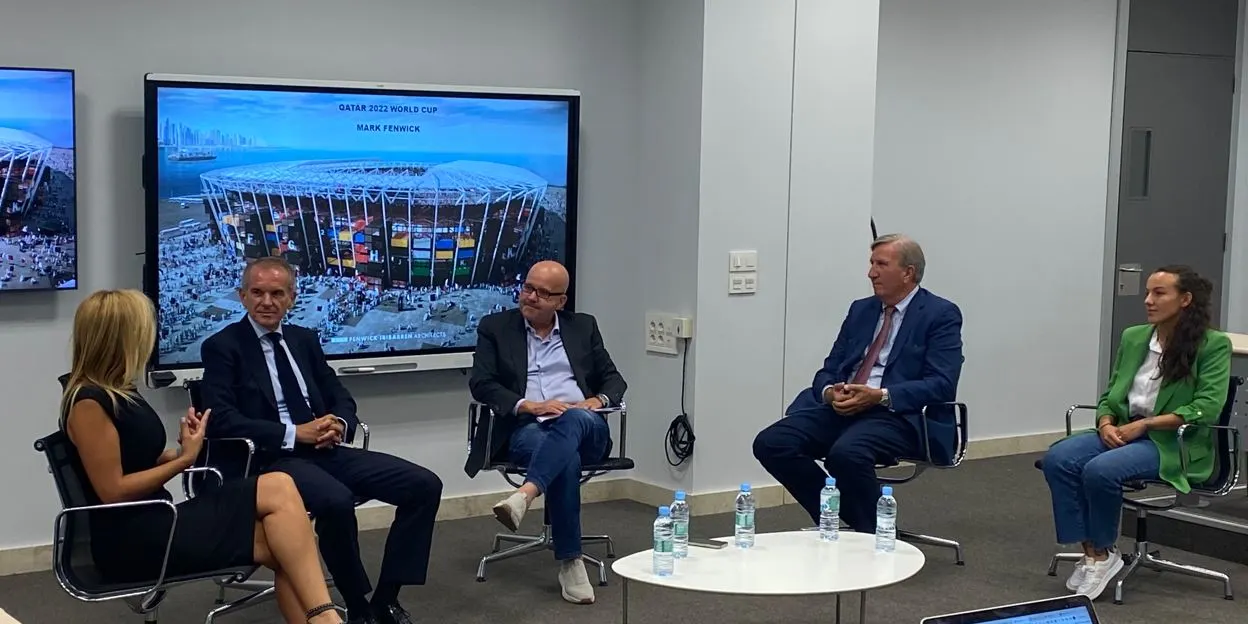
FIFA World Cup Qatar 2022 stadiums
‘With three stadiums, Spain has already scored the World Cup’s first hat-trick’
On 26 September, as part of its Executive Programme in Sports Business Administration (SBA), Centro de Estudios Garrigues hosted ‘The new challenges of football in the twenty-first century’. The lecture featured Mark Fenwick, architect of some of the World Cup’s most emblematic stadiums, who presented his unpublished projects; and Anair Lomba, former RCD Espanyol de Barcelona player and graduate of the SBA at Centro de Estudios Garrigues, who discussed the future of women’s football.
The event was moderated by Luis Villarejo Alonso, sports director at Agencia EFE, and included the participation of Félix Plaza Romero, president of Centro de Estudios Garrigues, and Rocío Martínez, sports presenter at Antena 3.
Mark Fenwick, founder of Fenwick Iribarren Architects, told the forum that Spain has already scored its first hat-trick at the FIFA World Cup Qatar 2022. Three of its new stadiums — Al-Thumama, where the Spanish national team will make its debut; Qatar Foundation; and Stadium 974 — included the participation of the Alcobendas-based architectural firm.
Fenwick spoke about the importance of acoustics in a stadium like the one located in Cornellá–El Prat — or in Al-Thumama, where the team led by Luis Enrique will kick off the World Cup campaign against Costa Rica. He also discussed the importance of the stands being close to the pitch. ‘These pitches are very close to the public. Our challenge was to make the first stadium an open stadium, not a closed one. A stadium where the wind could flow over, so that the hot air doesn’t get into the stadium. You can play in June with 42 °C. You can have 48 °C outside and 26 °C on the pitch. Stadiums are like cathedrals for the city,’ said the Spanish architect.
Stadium 974, known for its LEGO-like modular design and made of shipping containers, is the most visited by tourists and fans. It is the world’s first dismantlable stadium. At the end of the World Cup, it will be disassembled and moved to another country to be used in another major event. ‘We had a travelling circus in mind, but our model was the shipping container. The stadium can be assembled, disassembled, and taken somewhere else. It is made of almost 1,000 shipping containers, so it would only take a third of a cargo ship to transport it. It took two years to assemble it from scratch; disassembling it could take eight months, plus another year to reassemble it elsewhere. It can be moved to another country and even another continent. The name — Stadium 974 — comes from the number of shipping containers needed to transport it,’ explained the architect.
Félix Plaza Romero, president of Centro de Estudios Garrigues, pointed out that many of the investment funds looking to enter the sports world are undoubtedly looking to invest in stadiums. ‘We are now importing the American model. They realised a long time ago that you cannot operate only on Sundays. The clearest example of this approach is WiZink Center,’ added Félix Plaza Romero.
Asked by Rocío Martínez about whether the pandemic has changed the architecture of stadiums, Fenwick answered in the affirmative. ‘The pandemic has changed architecture. Not having to touch taps or doors, maintaining safety distances... There are a lot of new things that we are implementing. For example, using materials that do not hold onto the virus, such as copper; materials that are more hygienic and easier to clean; wider corridors, biometric accesses, etc.’
